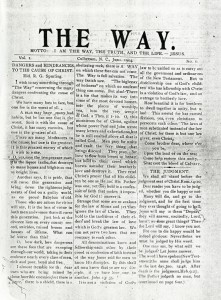“It Is A Very Good Paper”
“I send twenty-five cents for The Way,” Agnes Floyd of Michigan wrote to editors A.J. Tomlinson and M.S. Lemons in September 1905. Her letter continued, “It is a very good paper. I like to read such papers and then give them to others, praying that they may be led into the Way of life in the Savior.”
In an age of satellite television, wireless internet, and smart phones, a world that depended on the printed page for information and communication seems very distant. Yet the Church of God was born and flourished in such a world. Agnes Floyd and countless others read biblical and theological articles as well as ministry news in the pages of the religious periodicals of their day. Editors such as A.J. Tomlinson were keenly aware of the importance of the printed word to win the lost and inform readers of their ministries. By the time Tomlinson launched the Church of God Evangel in 1910, he had already gained editorial experience with three other publications.
 Tomlinson established Samson’s Foxes soon after arriving in Culberson, North Carolina. Subscriptions were 10 cents a year, and his editorial note in the January 1901 inaugural issue announced, “Samson’s Foxes is published monthly in the interest of the ‘Hundred Fold’ Gospel and the speedy evangelization of the mountain districts of North Carolina, Georgia, Tennessee, and the world.” The modest epistle’s title described the ministry Tomlinson envisioned. Samson had tied firebrands to the tails of foxes and burned the fields of the Philistines. Tomlinson’s ministry, and especially his school for children, would spread “God’s love to consume sinfulness and drive it from the hearts of men.” “My God is a consuming fire,” he declared.
Tomlinson established Samson’s Foxes soon after arriving in Culberson, North Carolina. Subscriptions were 10 cents a year, and his editorial note in the January 1901 inaugural issue announced, “Samson’s Foxes is published monthly in the interest of the ‘Hundred Fold’ Gospel and the speedy evangelization of the mountain districts of North Carolina, Georgia, Tennessee, and the world.” The modest epistle’s title described the ministry Tomlinson envisioned. Samson had tied firebrands to the tails of foxes and burned the fields of the Philistines. Tomlinson’s ministry, and especially his school for children, would spread “God’s love to consume sinfulness and drive it from the hearts of men.” “My God is a consuming fire,” he declared.
Articles in the four-page publication were intended to inspire readers as well as inform them of the Culberson ministry. Poetry, songs, and selections reprinted from other religious magazines filled the pages alongside appeals for funds for Tomlinson’s industrial home and school. The Culberson ministry was steeped in the American Holiness Movement and emphasized evangelism, sanctification, and divine healing. Samson’s Foxes called for abstinence from tobacco, opium, pork, tea, and coffee, and tied such a lifestyle to the importance of one’s health. Readers were admonished, “Were more attention paid to these laws of health, there would be a smaller field for drugs and divine healing.” Articles on evangelism often reported about Bible and tract distribution and the occasional testimony of a conversion. In several issues a “Childs Department” featured letters from children to Tomlinson’s eleven-year-old daughter Halcy. More than one article emphasized the important of humane care for animals.
Opposition, hardship, and discouragement pressed Tomlinson and his family to take a leave of absence from their Culberson ministry in November 1902, and Samson’s Foxes did not survive their departure. Returning to Culberson the next spring, Tomlinson intended to continue publishing. He purchased a printing press for $125 and wrote in his personal journal that he expected to “publish our little paper again soon.”
When Tomlinson did resume publishing in January 1904, it was a new publication titled The Way. M.S. Lemons was a coeditor, and the monthly paper carried the motto, “‘I am the way, the truth, and the life.’—Jesus,” on the front page. After a year the number of pages increased from four to eight and the subscription price rose from ten to twenty-five cents.
In June of 1903, Tomlinson had joined and been chosen as pastor of the Holiness Church at Camp Creek–the name of the Church of God from 1902 to 1907. The pages of The Way reflected Tomlinson’s leadership of a growing movement. Members of the Holiness Church did not consider themselves a denomination but rather part of the church that God was building.
Tomlinson published The Way for “the spread of the simple gospel of Jesus in its fullness, without making a specialty or ‘hobby’ of any one of His doctrines.” There were definite theological emphases reflected in its pages, however. R.G. Spurling wrote about the importance of love and the dangers of creeds. R. Frank Porter, who with Spurling had set in order the Holiness Church at Camp Creek in 1902, wrote a Bible lesson on sanctification. Other emphases included foot washing, divine healing, evangelism, revival, the Second Coming, and Sunday school. Later installments carried the motto: “‘Jesus Christ the same yesterday, and today, and forever.’ He saves, sanctifies, heals.”
The ministerial activities of the editors were especially highlighted in The Way. One issue listed places where Tomlinson and Lemons were preaching. These included Camp Creek, North Carolina, the Jones residence in Fannin County Georgia, and both Drygo and Union Grove in Tennessee. Each of these congregations later sent delegates to the first General Assembly in 1906. Other preaching stations were Luskville, Tennessee, and Ballknob, Georgia. A May 29, 1904, meeting at Drygo proved too large for the schoolhouse so seats were arranged in a nearby grove for the morning service. That afternoon seven were baptized in a nearby creek and five received into the church.
In September 1905, the editors made a surprising announcement. They wrote, “On account of the demands of evangelistic and pastoral work, we have decided to discontinue publication of The Way and give our time to the other work.” They informed readers that unfulfilled subscriptions would be transferred to a Missouri weekly, The Church Herald.
Without their own paper, Church of God members turned to other publications. Beginning in 1907, G.B. Cashwell edited one of the best known Pentecostal publications, The Bridegroom’s Messenger. Tomlinson invited Cashwell to Cleveland and received the baptism of the Holy Spirit following Cashwell’s sermon on January 12, 1908.
When Cashwell recruited Tomlinson as a corresponding editor of The Bridegroom’s Messenger, that publication became widely read by Church of God members. It came to be a vital source of information about Church of God people and activities. Evangelist Ella Clyde Cotton reported in the September 15, 1908, issue about the 10-week Cleveland, Tennessee, revival in the fall of 1908. Other Church of God ministers contributed sermons and reported their revivals. W.F. Bryant sought support for his mountain missionary work in the pages of the Messenger.
Despite the availability of The Bridegroom’s Messenger, Church of God members desired their own periodical. The need to communicate both the good news of the gospel as well as what God was doing in the Church of God soon led Tomlinson and the General Assembly to establish the Church of God Evangel in 1910.
[Note: All available issues of Samson’s Foxes, The Way, and the Church of God Evangel (through 1923) along with many other publications are available on the CD-Rom Church of God Publications, 1901-1923. To purchase one, send $29.95 to Dixon Pentecostal Research Center, 260 11th Street NE, Cleveland TN 37311; or visit www.pathwaybookstore.com.]
————————————————-
This article was written by Church of God Historian David G. Roebuck, Ph.D., who is director of the Dixon Pentecostal Research Center and assistant professor of the history of Christianity at Lee University. This “Church of God Chronicles” was first published in the March 2010 Church of God Evangel.




